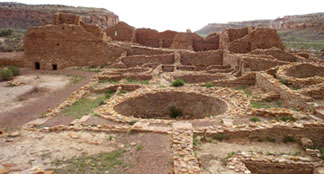For the past 30 years, paleoclimatologists have used stalagmite banding to peek into Earth’s climate past. Now, two University of New Mexico scientists have compiled the longest span of annual banding in stalagmites. Their findings in the Oct. 5 Science link Late Holocene climate to cultural changes in the Southwest.
 Victor
Polyak and Yemane Asmeron analyzed annual banding, breaks in the stratigraphic
record and high-precision uranium-series dating in columnar stalagmites in the
caves of New Mexico’s Guadalupe Mountains to determine a 4,000-year, annually
resolved climate history. Seasonal differences in surface precipitation and
seasonal changes in the cave climate create layers of alternating clear and
dark calcite. The darker layers contain microflora that have settled on the
stalagmites during drier periods, and the clear layers represent faster growth
during wet periods.
Victor
Polyak and Yemane Asmeron analyzed annual banding, breaks in the stratigraphic
record and high-precision uranium-series dating in columnar stalagmites in the
caves of New Mexico’s Guadalupe Mountains to determine a 4,000-year, annually
resolved climate history. Seasonal differences in surface precipitation and
seasonal changes in the cave climate create layers of alternating clear and
dark calcite. The darker layers contain microflora that have settled on the
stalagmites during drier periods, and the clear layers represent faster growth
during wet periods. [Victor Polyak and Yemane Asmeron studied the abandoned caves of Pueblo del Arroyo at Chaco Canyon in the Chaco Culture Historical Park in New Mexico to link cultural changes to regional climate change. Courtesy of Yemane Asmeron.]
Polyak and Asmeron report a present day-like climate from 4,000 to 3,000 years ago followed by a distinctly colder and wetter period from 3,000 to 800 years ago, and then present day-like conditions with the exception of a slightly wetter interval from 440 to 290 years ago. Researchers have not reached a consensus on late Holocene climate of the southwestern United States, Polyak says. But their results, “having the most complete absolute chronology covering the whole period, make a compelling case for cooler and wetter conditions for the late Holocene.”
Polyak and Asmeron found a good correlation between climate record and the archaeological record of cultural activities of indigenous people. Earliest evidence that ancestral Americans growing corn in the southwestern United States, for example, coincides with the beginning of the late Holocene wet period as defined in their research. They have high hopes that their research will provide a first step toward a mechanistic understanding of climate change. “I was born and grew up in Eritrea [Horn of Africa], a part of the world that, over the years, has been the ‘poster child’ for drought and political instability. I would not need to explain to anyone from that area the importance of climate research,” Asmeron says.

